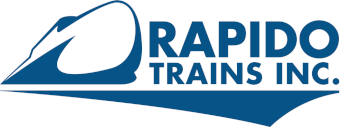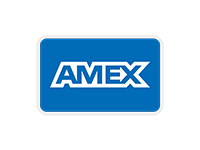By Alex Stroshane
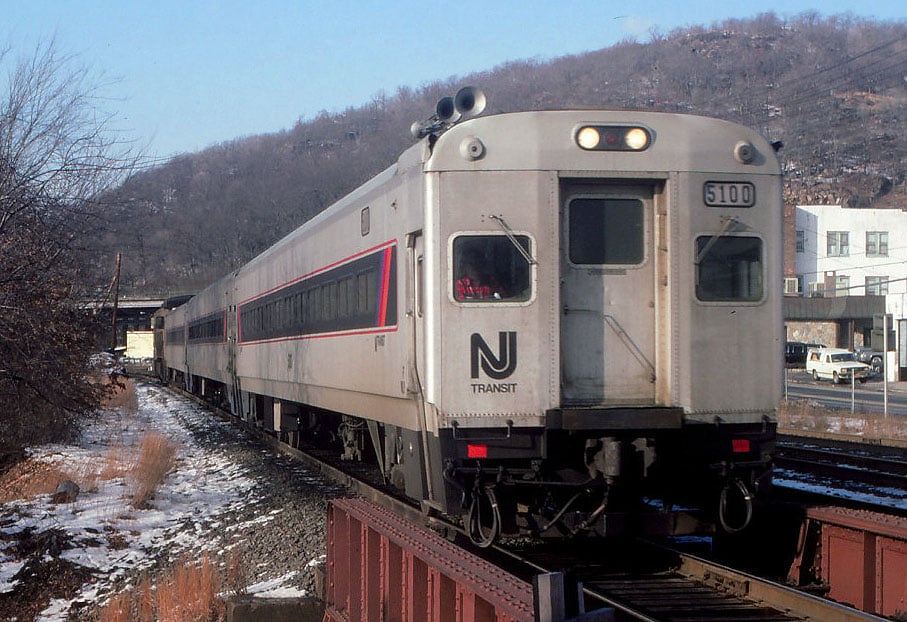
Still wearing its original livery, but with New Jersey Transit decals replacing the original EL/NJDOT logos, Comet I class leader 5100 leads an inbound train through Suffern, NY. Photo by Tom Beckett,used with permission.
A Comet is Born
In the 1960s, commuter service operated by various railroads around New York and New Jersey was not what it once had been. Ridership levels were dropping, thanks to commuters’ increased use of automobiles, and much of the passenger equipment had been in use for several decades. The state governments began to recognize that these operations would not be profitable on their own, and decided to subsidize the operating costs in order to improve the service. On the Erie Lackawanna, which operated trains from the outer suburbs into Hoboken Terminal, the New Jersey Department of Transportation funded the purchase of new locomotives and cars. Between 1970 and 1973, General Electric built 32 U34CHdiesels, equipped to provide head-end power (HEP) for lighting and climate control, and Pullman-Standard delivered 155 passenger cars of a distinctly modern design.
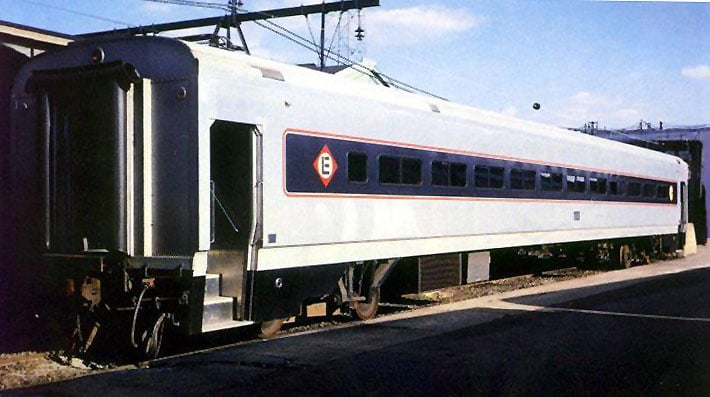
Shown here in its as-built configuration, this Dieseliner coach carries EL and NJDOT markings. Photo courtesy of the Erie Lackawanna Dining Car Preservation Society, which now owns and operates two of these cars on excursion trips.
Initially called Dieseliners, these cars were set up for push-pull operation, where the diesel could be controlled from a cab car on the return trip. Their wide, squared-off aluminum bodies allowed maximum passenger capacity, while the attractive brushed finish would reduce maintenance costs. Vestibules at both ends of the car, equipped with sliding doors and fixed stepwells, made loading and unloading easier. Since high-level platforms were not common on EL commuter lines at that time, the door openings were lowered to accommodate low-level platforms. The cars rode on General Steel Industries inside-bearing trucks, and their lack of side skirts meant that all underbody equipment was easily accessible for maintenance.
Just a few years later, in 1976, the Erie-Lackawanna was one of several railroads that were folded into Conrail as they struggled financially. Conrail thus became the operator of the EL’s commuter services, but in 1979, New Jersey Transit was created as a result of the state’s Public Transportation Act. Around this time, the Dieseliners became known as Comets, a tribute to the Blue Comet service formerly operated by the Central Railroad of New Jersey.
The Next Generation
In Boston, the Massachusetts Bay Transportation Authority (MBTA) had been facing similar issues with its aging equipment. Its commuter lines north and south of Boston were served by a mixture of Budd RDC cars, ex-New Haven 8600-series coaches, and sets of Hawker-Siddeley commuter cars borrowed from GO Transit in Toronto. Starting in 1977, it too received new push-pull equipment from Pullman-Standard, which was a slightly modified version of the Comet design. The doorways were now taller to allow boarding from high-level platforms, while trap doors would still allow access to low-level platforms when needed. Stronger collision posts caused the ends of the cars to bulge out slightly in the middle, and the streamlined cab roof of the original design was simplified to match the blind end of the car. MBTA designated these cars BTC-1 and CTC-1, which stood for Blind Trailer Coach and Control Trailer Coach.
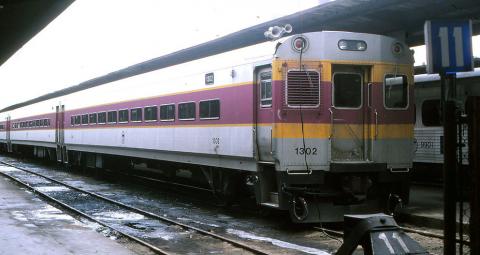
A train of MBTA BTC-1 and CTC-1 cars sits in Boston’s North Station. Note the borrowed GO Transit equipment on the next track. Photo by Tom Beckett, used with permission.
As Pullman began to make their exit from the car building industry in the early 1980s, New Jersey Transit was looking to expand its push-pull fleet. This resulted in the Comet design being licensed to Bombardier, which in 1982 started construction of an updated version, the Comet II. These cars looked very similar to the MBTA order, with taller doors that could access high or low platforms. The most visible difference was the change from split window glazing to one-piece, FRA-compliant safety glass.
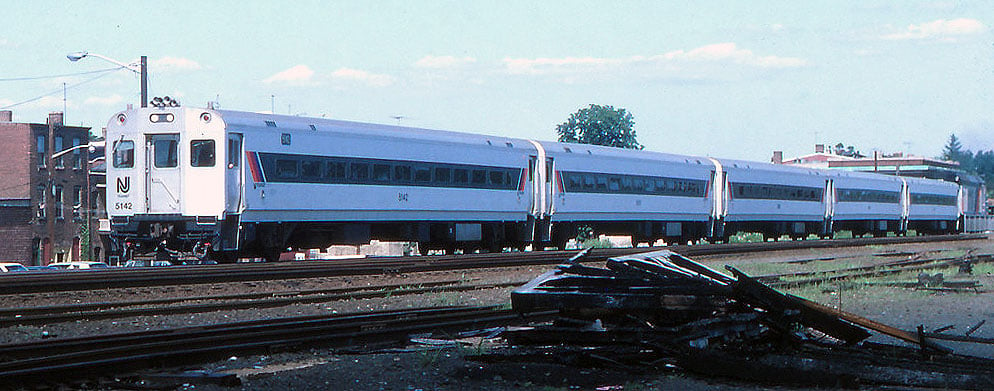
NJT cab car 5142 leads a matched set of new Comet II equipment through Bound Brook, NJ.Photo by Tom Beckett, used with permission.
NJ Transit’s first Comet II order consisted of cab cars and trailers, one of which was built with a special club section occupying half of the car. Ever since then, this section has been leased by the Jersey Shore Commuters Club, whose members pay annual dues for the privilege to ride in a quiet, spacious seat.An additional order for more trailers was placed in 1987, including a group equipped with lavatories. These became known as Comet IIB, and the original cars are often termed Comet IIA to differentiate them.
In 2002, all of NJ Transit’s Comet II cars were rebuilt by Alstom to include some of the features found on later Comet III and IV cars, such as automatic sliding step trap cover.
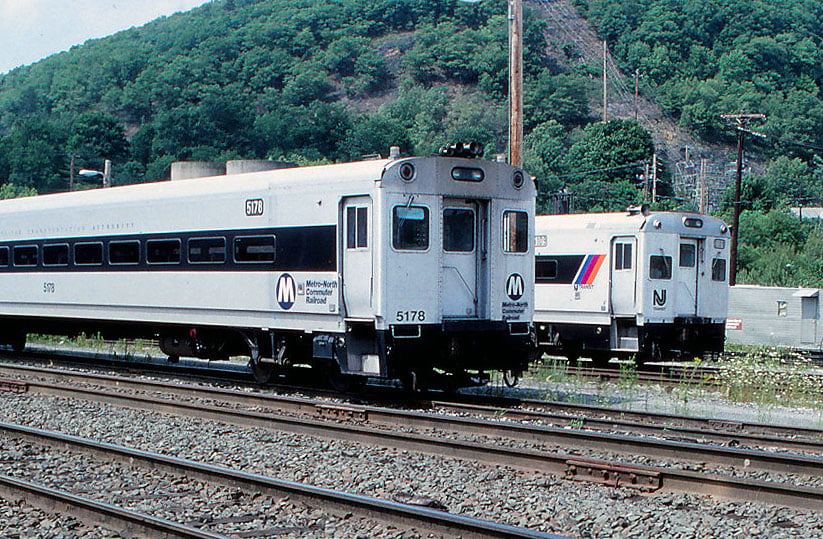
Compare this Metro-North West-of-Hudson Comet II cab car to a New Jersey Transit Comet I cab as they both lay over in Port Jervis, NY. Note that this Comet I was rebuilt with high-platform doors. Photo by Tom Beckett, used with permission.
Around the same time as NJ Transit’s first order, Metro-North placed an order for nearly identical cab cars and trailers, which were assigned to West-of-Hudson service that is operated by NJ Transit. This 87-mile route allows commuters from as far away as Port Jervis, New York to arrive at Hoboken Terminal in New Jersey for access to New York City. Additional cars were purchased in 1987, some of which included lavatories. This group of cars remained captive to West-of-Hudson service until the arrival of new Comet V cars in 2002. At that point, they were overhauled and renumbered to join the rest of Metro-North’s push-pull fleet.
Rising in Popularity
The success of the Comet II design was noticed by other commuter agencies, and throughout the 1980s many more were built:
- SEPTA ordered cab cars and trailers for push-pull service on the Northeast Corridor, hauled by its AEM-7 and ALP-44 electric locomotives. These were designated JWC-II by SEPTA, but are nearly identical to New Jersey Transit Comet II cars.
- MBTA ordered additional cab cars and trailers to supplement its original Pullman-Standard cars, which were all later rebuilt into trailers.
- Montreal’s MUCTC (also known as STCUM,and later AMT)ordered a small fleet of cars built with longer doors, which covered the low-level stepwells to prevent snow from getting in.
- Amtrak’s Horizon Fleet, consisting of short-haul coaches and food service cars, was based heavily on the Comet design. They differ from the commuter versions by having outside-bearing trucks, manually-operated side doors, and different interior configurations. You can read more about them at our Horizon Car Master Class page.
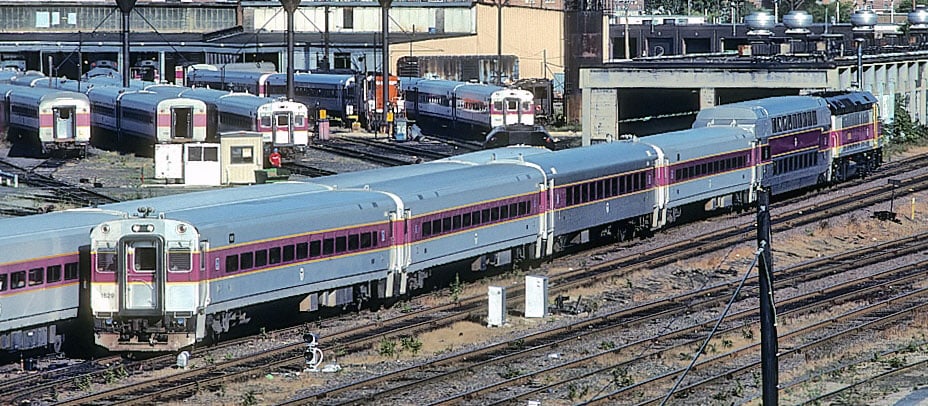
In this 1991 view, several new sets of Bombardier-built cars are seen at MBTA’s Boston Engine Terminal, along with a handful of older Pullman-Standard cars at left. Photo by Marty Bernard, used with permission.
Shoreliner Variant
Starting in 1985, Metro-North also placed several orders for a variation of the Comet, known as the Shoreliner. Most of these cars were assigned names honoring the history of the region, which are displayed on the car sides. A portion of the fleet is actually owned by the Connecticut Department of Transportation (CDOT), thanks to its operating agreement with Metro-North for service into New York. These cars wear red stripes instead of blue and carry additional lettering to identify their ownership.
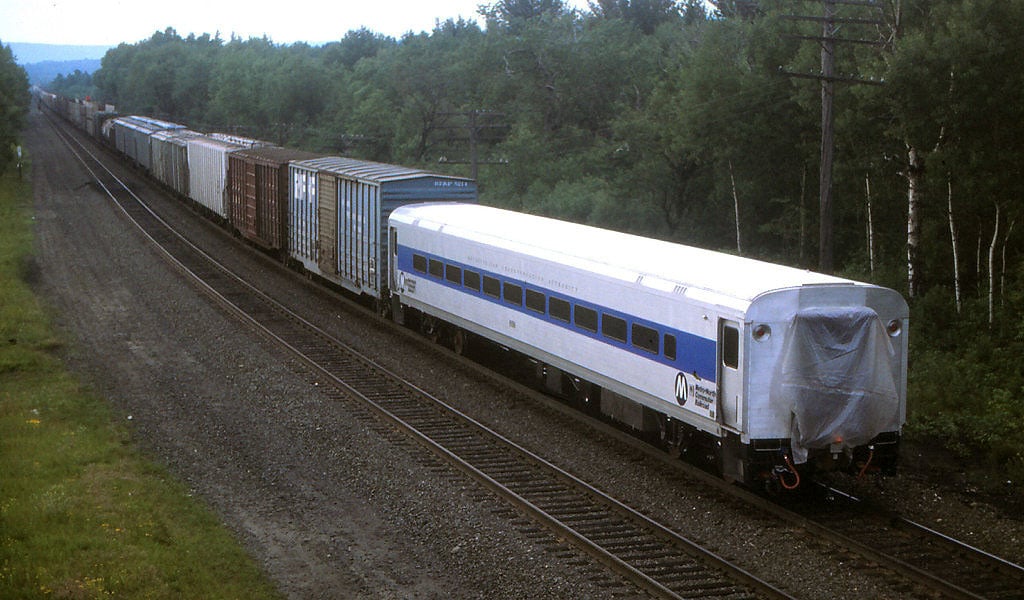
A brand-new Metro-North Shoreliner I coach heads west on Conrail’s Boston Line, having been interchanged off the Central Vermont in Palmer, MA. Photo by Tom Beckett, used with permission.
Externally, the Shoreliners look almost identical to the Comets, with the exception of the cab front. Unlike all other Comet versions, the Shoreliner cabs lack a front window on the fireman’s side. In its place, the Metro-North logo and/or Connecticut state seal are prominently displayed.
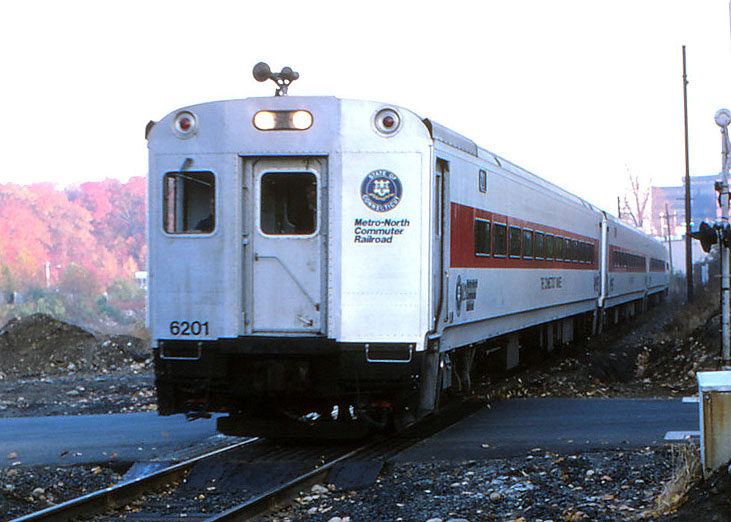
CDOT’s first Shoreliner I cab car is leading a New York-bound train down the Danbury Branch in Norwalk, where it joins the New Haven Line. Photo by Tom Beckett, used with permission.
Also of note is a small group of Shoreliners built in 1991 for CDOT’s fledgling Shore Line East service. In addition to cab cars and standard trailers, this fleet included four trailers equipped with HEP generators. These allowed Shore Line East trains to be hauled by locomotives that were not HEP-equipped. The exhaust duct for the HEP generator ran up through the interior on one side, taking the place of a seat. On the outside, one of the windows was divided into two small windows with a blank space between, and there was a small exhaust stack located on the roof.

Former Shore Line East HEP car 1646 “Governor Jonathan Trumbull,” later renumbered 6240, waits with a train at Waterbury.Note the two small windows and exhaust stack at the center of the car. Photo by Tom Beckett, used with permission.
Eventually, the Shore Line East cars were transferred to the rest of the MNRR/CDOT pool fleet, being renumbered in the process. They were replaced by Brazilian-built Mafersa coaches that CDOT purchased in 2004 from Virginia Railway Express.
Continued Evolution
To facilitate faster loading and unloading of passengers, New Jersey Transit ordered a fleet of Comet III cars in 1990 that were equipped with center doors in addition to the end doors. Much like those of a subway train, these double sliding doors could open wide to swallow rush-hour crowds at high-level platforms. They also made the cars ADA-compliant thanks to the wider opening. Another new feature was automatic stepwell covers, which could slide open along with the end doors when stopping at low-level platforms.
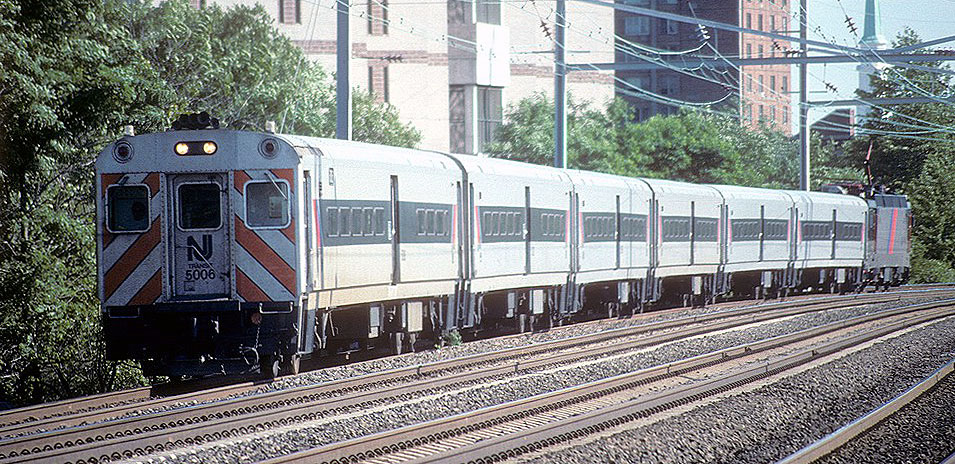
NJT Comet III cab car 5006 leads a train of its center-door brethren, pushed by an ALP-44 electric. Photo by Marty Bernard, used with permission.
Metro-North followed suit with their own order of Shoreliner III cars with center doors. This time, the cab cars included a window on the fireman’s side like the rest of the Comets. The final evolution in this series were the Comet IV and Shoreliner IV, which eliminated the end door on the engineer’s side for increased safety.
As an epilogue, the Comet moniker continues to be used by New Jersey transit to this day for its push-pull cars. Comet V cars were built by Alstom starting in 2002, and while they share a similar overall layout to the previous cars, their design is distinctly different. Meanwhile, the Multi-Level cars built by Bombardier since 2006 are sometimes known as the Comet VI.
Typical Car Construction
Shown below are diagrams illustrating the equipment and layout of MBTA’s 1600-series cab cars. Cars built for other railroads may have some differences, which will be covered later.
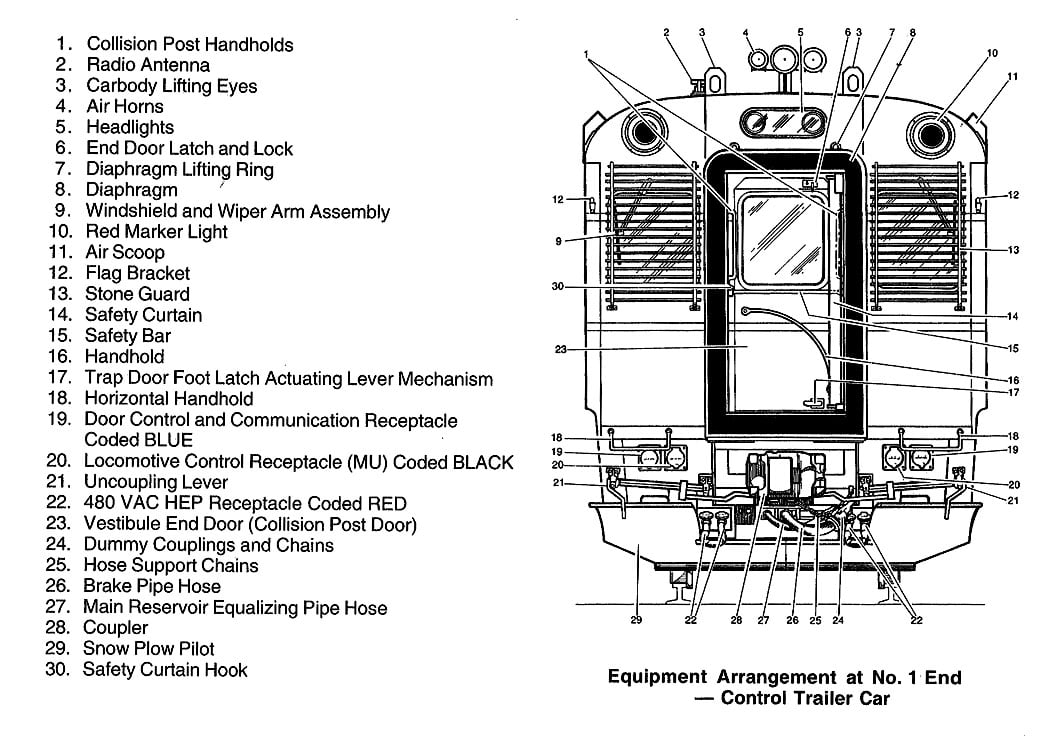
Underneath the cars, the equipment layout is also fairly standard. Some versions may have additional components, such as retention toilets, cab signaling equipment, etc. Also, trailer cars lack the sand boxes and the two outboard air reservoirs found on cab cars, having only the main supply reservoir in the center.
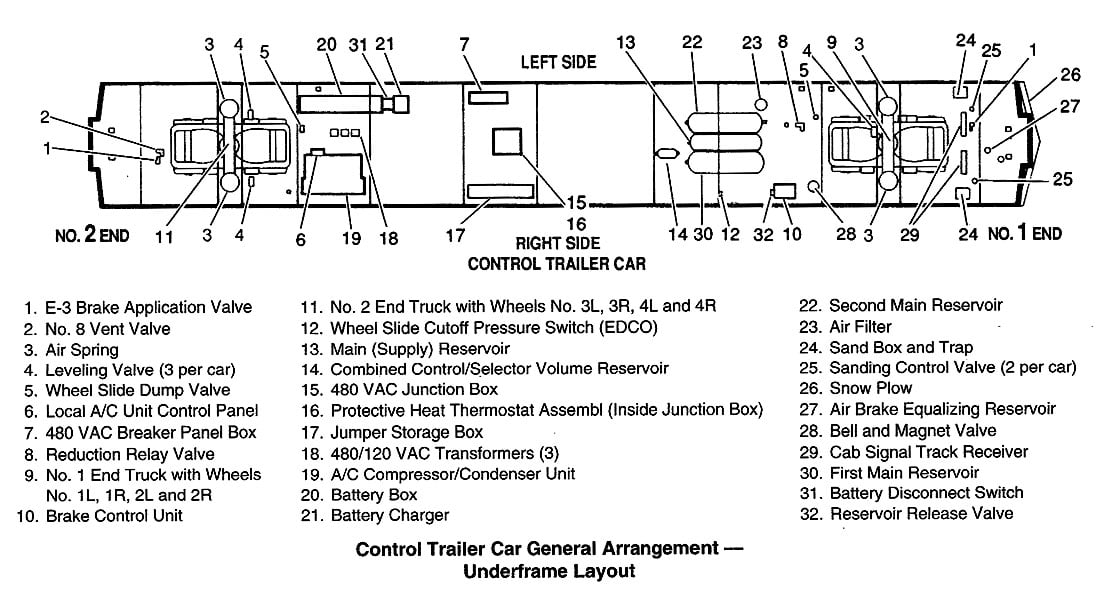
Inside the cars, passenger capacity is maximized through the use of 3+2 seating. The arrangement shown below for MBTA cars seats 122, but other versions can seat up to 131. Fewer seats are available when the car is equipped with a lavatory, center door or wheelchair access.
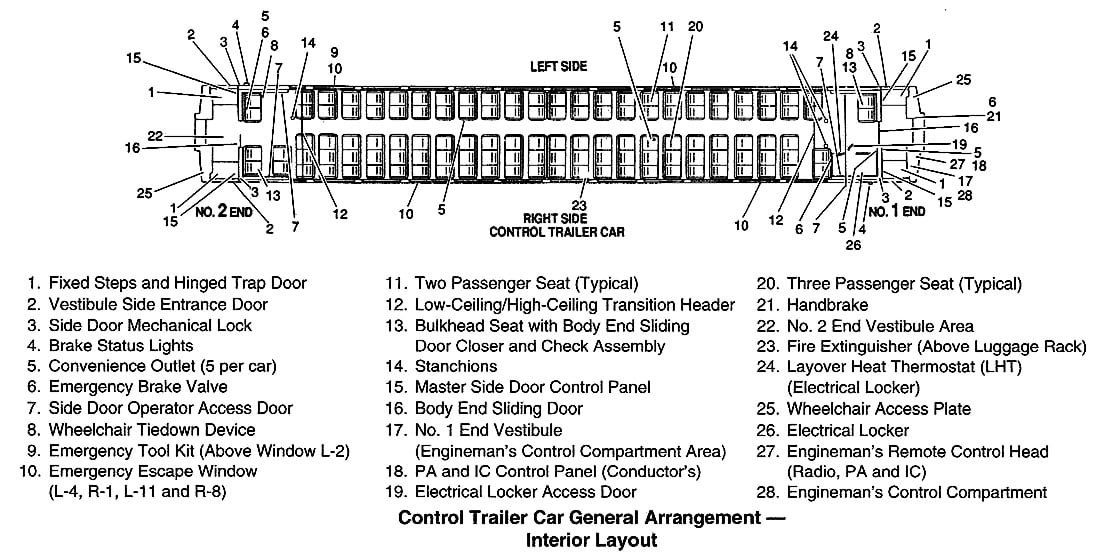
Road-Specific Details
Aside from the missing fireman’s sidewindow on Metro-North and CDOT cab cars, most of the differences from one owner to another are fairly subtle. The majority are found on the cab front, since a variety of different options could be specified according to each road’s preferences. Examples include:
- Air horn type (K5LA, K3LA, etc.)
- Diaphragm type (tubular, Amtrak-style, or no diaphragm on cab end)
- Lighting (ditch lights, marker lights, strobe lights)
- Snowplow style(large or small)
- Stepwell configuration (three or four steps)
New Jersey Transit:

NJT 5139 brings up the markers as its train passes through South Amboy, NJ. Photo by Tom Beckett, used with permission.
MNCR/CDOT:
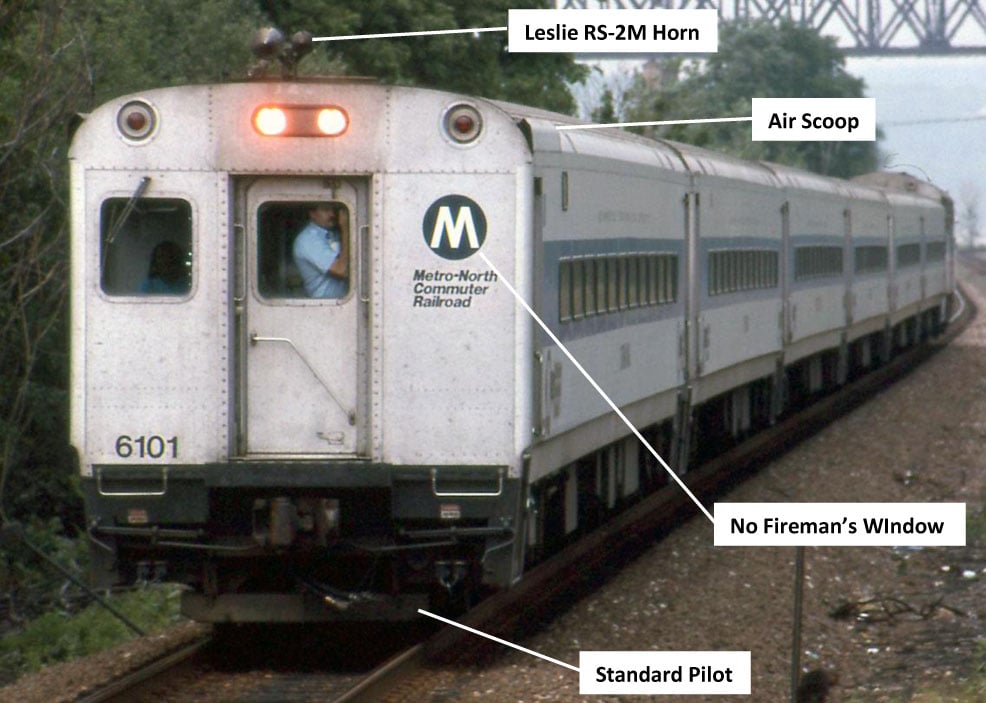
Metro-North Shorelinercab car 6101 leads a New York-bound train at Beacon, NY.Photo by Tom Murray, used with permission.
MBTA:
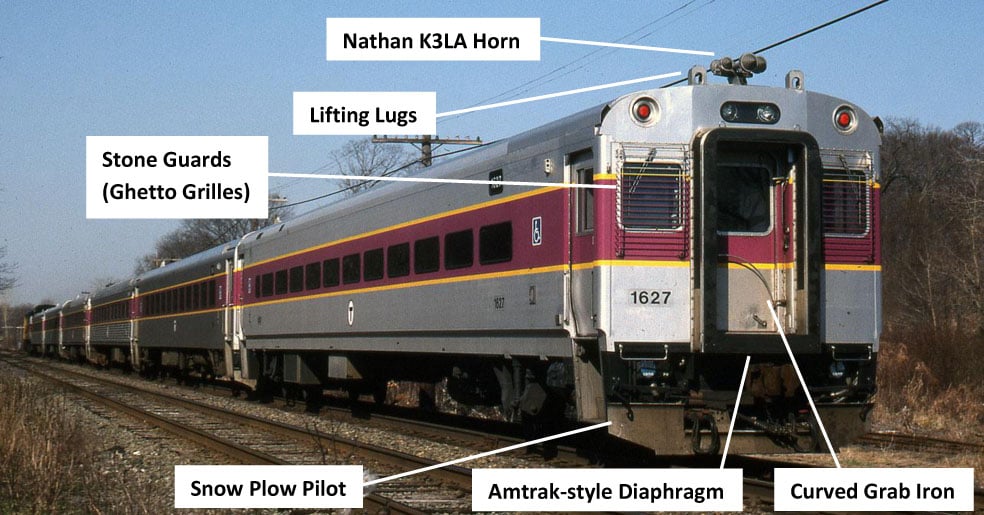
MBTA CTC-1B 1627 was built in 1989 and differs slightly in appearance from the 1977 Pullman-Standard cars. Photo by Joe Snopek, collection of Alex Stroshane.
MUCTC/AMT:
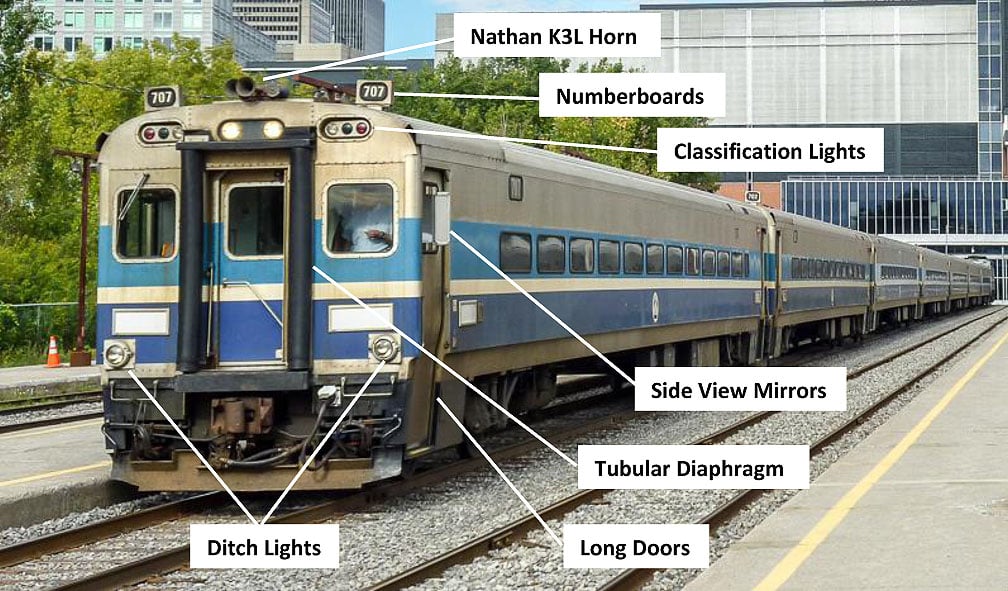
AMT cab car 707 waits with a train at Lucien-L'Allier Station in Montreal. Photo by Matt Donnelly, used with permission.
SEPTA:
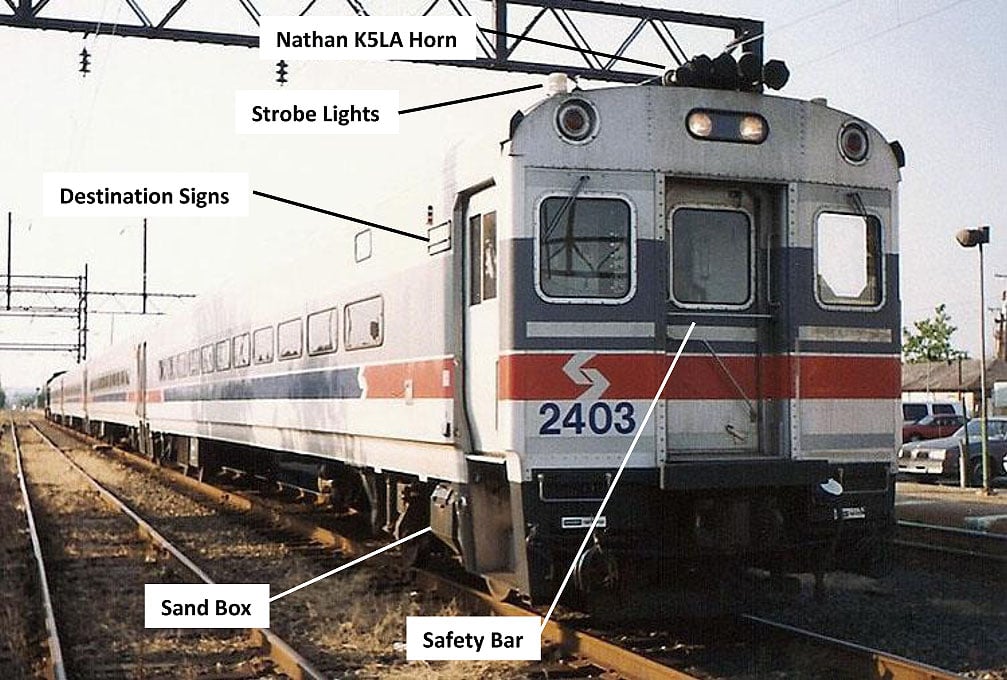
SEPTA JWC-II cab car 2403 leads a train at Lansdale, PA. Photo by Joe Parlin, used with permission.
CDOT:
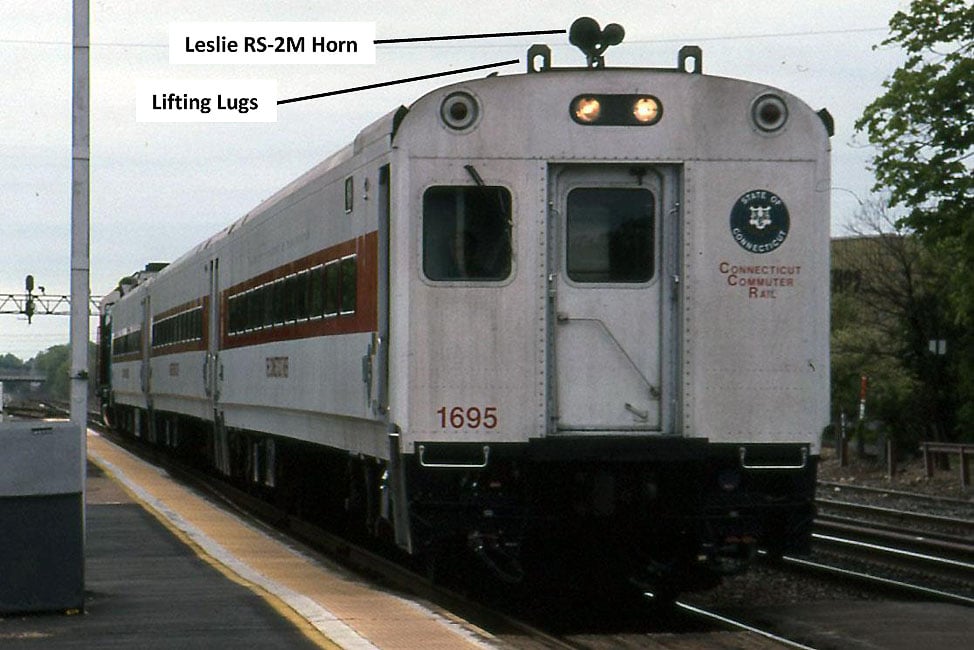
Shore Line East cab car 1695 arrives at Old Saybrook with a westbound train.Photo by Tom Murray, used with permission.
Complete Roster of Comet II and Variations
Since the Rapido models are based on the Comet II series and its variants, this roster lists the original roadnumbers and build dates for all such cars. It does not include the earlier Comet I, or the later Comet III and IV, because there are significant external differences between those and the Comet II.
| Railroad | Roadnumbers | Type | Builder | Designation | Built | Notes |
|---|---|---|---|---|---|---|
| NJT | 5134-5154(1) | Cab Car | Bombardier | Comet IIA | 1982-1983 | |
| NJT | 5610-5706(1) | Trailer | Bombardier | Comet IIA | 1982-1983 | |
| NJT | 5752-5771(1,2) | Trailer | Bombardier | Comet IIB | 1988 -1989 | |
| NJT | 5800-5824(1) | Trailer | Bombardier | Comet IIB | 1987-1988 | Equipped with toilet |
| MBTA | 300-344(3) | Trailer | Pullman-Standard | BTC-1 | 1978-1979 | |
| MBTA | 1300-1314(3) | Cab Car | Pullman-Standard | CTC-1 | 1978-1979 | |
| MBTA | 350-389 | Trailer | Bombardier | BTC-1A | 1987-1988 | |
| MBTA | 600-653 | Trailer | Bombardier | BTC-1B | 1989-1990 | |
| MBTA | 1600-1652(4) | Cab Car | Bombardier | CTC-1B | 1989-1990 | |
| MNRR (WOH) | 5175-5177(5) | Cab Car | Bombardier | Comet IIA | 1983 | |
| MNRR (WOH) | 5178(5) | Cab Car | Bombardier | Comet IIB | 1988 | |
| MNRR (WOH) | 5986-5987(6) | Trailer | Bombardier | Comet IIB | 1987 | |
| MNRR (WOH) | 5988-5993(6) | Trailer | Bombardier | Comet IIA | 1983 | |
| MNRR (WOH) | 6000-6003(7) | Trailer | Bombardier | Comet IIB | 1987 | Equipped with toilet |
| MNRR | 6101-6109 odd | Cab Car | Bombardier | Shoreliner I | 1985 | |
| MNRR | 6111-6119 odd | Cab Car | Bombardier | Shoreliner II | 1987 | |
| MNRR | 6121-6123 odd | Cab Car | Bombardier | Shorliner II | 1991 | Only 1 cab end window |
| MNRR | 6150-6160 | Trailer | Bombardier | Shoreliner I | 1985 | Odd numbers equipped with toilets |
| MNRR | 6162-6166 even | Trailer | Bombardier | Shoreliner I | 1985 | |
| MNRR | 6161-6167 odd | Trailer | Bombardier | Shorliner II | 1987-1988 | Equipped with toilets |
| MNRR | 6168-6174 | Trailer | Bombardier | Shoreliner II | 1987-1988 | Odd numbers equipped with toilets |
| MNRR | 6175-6179 odd | Trailer | Bombardier | Shoreliner II | 1991 | Equipped with toilets |
| MNRR | 6176-6184 even | Trailer | Bombardier | Shoreliner II | 1988 | |
| MNRR | 6186-6190 even | Trailer | Bombardier | Shoreliner II | 1991 | |
| CDOT (SLE) | 1614-1616 even (8) | Trailer | Bombardier | Shoreliner II | 1991 | |
| CDOT (SLE) | 1640-1646 even (9) | Trailer | Bombardier | Shoreliner II | 1991 | HEP power cars |
| CDOT (SLE) | 1691-1697 odd (10) | Cab Car | Bombardier | Shoreliner II | 1991 | Only 1 cab end window |
| CDOT | 6201-6209 odd | Cab Car | Bombardier | Shoreliner I | 1985 | Only 1 cab end window |
| CDOT | 6211-6219 odd | Cab Car | Bombardier | Shoreliner II | 1991 | Only 1 cab end window |
| CDOT | 6262-6268 even | Trailer | Bombardier | Shoreliner I | 1985 | |
| CDOT | 6270-6278 even | Trailer | Bombardier | Shoreliner II | 1991 | |
| SEPTA | 2401-2410 | Cab Car | Bombardier | JWC-II | 1987 | |
| SEPTA | 2501-2525 | Trailer | Bombardier | JWC-II | 1987 | |
| MUCTC | 700-707 | Cab Car | Bombardier | Comet IIB | 1989 | Equipped with long doors |
| MUCTC | 710-725 | Trailer | Bombardier | Comet IIB | 1989 | Equipped with long doors |
Roster Footnotes:
- All NJT Comet II cars rebuilt as trailers in 2002 by Alstom. Reclassed Comet IIM, renumbered 5300-5460.
- NJT 5759 built with club section, leased by Jersey Shore Commuters Club.Later renumbered 5459.
- MBTA BTC-1 and CTC-1 cars rebuilt as trailersin 1996 by Amerail. Reclassed BTC-1C, renumbered 200-258.
- MBTA 1600-1624 had cab controls deactivated in 1992 and have since been used as trailers.
- MNRR West-of-Hudson 5175-5178 later renumbered to 6125-6131 (odd).
- MNRR West-of-Hudson 5986-5987 and 5988-5993 later renumbered to 6134-6148 (even).
- MNRR West-of-Hudson 6000-6003 later renumbered to 5980-5983 and then 6143-6149 (odd).
- CDOT Shore Line East 1614-1616 (even) later renumbered to 6230-6232 (even).
- CDOT Shore Line East 1640-1646 (even)later renumbered to 6234-6240 (even).
- CDOT Shore Line East 1691-1697 (odd)later renumbered to 6223-6229 (odd).
References:
Dieseliners Coaches. Erie Lackawanna Dining Car Preservation Society.
Erie Lackawanna/NJDOT Comet I Commuter Cars. Whippany Railway Museum.
The Illustrated Commuter Roster by El Simon. Passenger Train Annual, 1990.
Amtrak’s Horizon Fleet cars by Bob Birkholz and Julian Cavalier. Railroad Model Craftsman, November 1992.
Modeling Modern Bombardier Commuter Cars by Frank Cicero. Railroad Model Craftsman, May 1995.
Modeling NJ Transit Comet IV Cars by Frank Cicero. Railroad Model Craftsman, October 1998.
